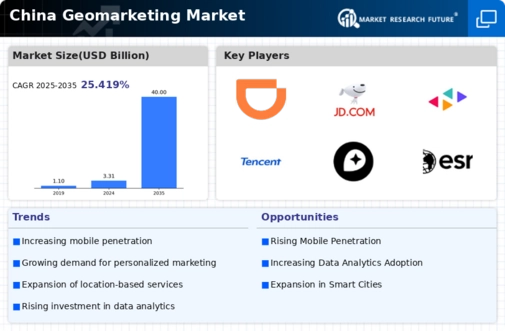Emergence of Smart Cities
The development of smart cities in China significantly influences the geomarketing market. As urban areas become increasingly interconnected through technology, the demand for location-based services rises. Smart city initiatives aim to enhance urban living by integrating data-driven solutions, which creates opportunities for businesses to engage with consumers in innovative ways. In 2025, it is projected that smart city investments will exceed $100 billion, driving the need for geomarketing strategies that align with urban planning. Companies can utilize geospatial data to tailor their offerings to the unique needs of smart city residents, thereby enhancing customer satisfaction. This trend indicates a promising future for the geomarketing market as it adapts to the evolving urban landscape.
Increased Focus on Data Privacy
As the geomarketing market in China evolves, there is a growing emphasis on data privacy and security. Consumers are becoming more aware of how their location data is used, prompting businesses to adopt transparent practices. In 2025, it is estimated that 60% of consumers will prioritize brands that demonstrate a commitment to data protection. This shift compels companies to implement robust data management strategies, ensuring compliance with regulations while still leveraging location data for marketing. By addressing privacy concerns, businesses can build trust with their customers, ultimately enhancing their geomarketing efforts. This focus on data privacy is likely to shape the future landscape of the geomarketing market.
Advancements in Mobile Technology
The rapid evolution of mobile technology significantly impacts the geomarketing market in China. With over 1 billion smartphone users, the ability to collect and analyze location data in real-time is unprecedented. This technological advancement allows businesses to implement targeted marketing strategies based on user location and behavior. In 2025, mobile advertising is expected to account for nearly 70% of total digital ad spending in China, highlighting the importance of geomarketing. Companies are increasingly utilizing mobile applications to engage consumers through location-based promotions and personalized offers. As mobile technology continues to advance, the geomarketing market is likely to expand, offering new opportunities for businesses to connect with their target audiences.
Rising Demand for Location Intelligence
The geomarketing market in China experiences a notable surge in demand for location intelligence solutions. Businesses increasingly recognize the value of geospatial data in enhancing decision-making processes. In 2025, the market is projected to grow by approximately 15%, driven by the need for precise targeting and improved customer engagement. Companies leverage location intelligence to optimize their marketing strategies, ensuring that campaigns resonate with local audiences. This trend is particularly evident in urban areas, where consumer behavior is influenced by geographic factors. As organizations seek to gain a competitive edge, the integration of location intelligence into their operations becomes essential, thereby propelling the geomarketing market forward.
Government Initiatives Supporting Geospatial Data
Government initiatives in China play a crucial role in fostering the growth of the geomarketing market. The Chinese government has invested heavily in developing geospatial infrastructure, including satellite systems and mapping technologies. These investments enhance the availability and accuracy of location data, which businesses can leverage for marketing purposes. In 2025, the government aims to increase the accessibility of geospatial data by 30%, facilitating its integration into various sectors. This supportive environment encourages companies to adopt geomarketing strategies, as they can rely on reliable data sources for informed decision-making. Consequently, the geomarketing market is poised for growth, driven by these favorable government policies.
























Leave a Comment